Report on Natural and Hybrid Ventilation Systems for Office Buildings
VerifiedAdded on 2020/04/21
|23
|4584
|205
Report
AI Summary
This report provides a comprehensive analysis of natural and hybrid ventilation systems for a proposed office building, considering two potential sites: an urban center and a greenfield location. The study delves into various aspects of building physics, including stack pressure, wind-induced pressure, and air flow networks, to optimize the design for energy efficiency and indoor air quality. The report calculates pressure differences at external openings, analyzes ventilation flow rates, and determines heat loss and energy requirements for both winter and summer conditions. It explores the use of hybrid ventilation strategies to balance environmental energy with mechanical systems, ensuring occupant comfort and control. Furthermore, the report addresses the challenges posed by seasonal variations and provides detailed calculations for ventilation heat loss and cooling energy requirements. The analysis also considers additional restrictions for the urban site and explores strategies to improve indoor air quality in urban settings, making it a valuable resource for understanding and designing effective ventilation systems in office buildings.
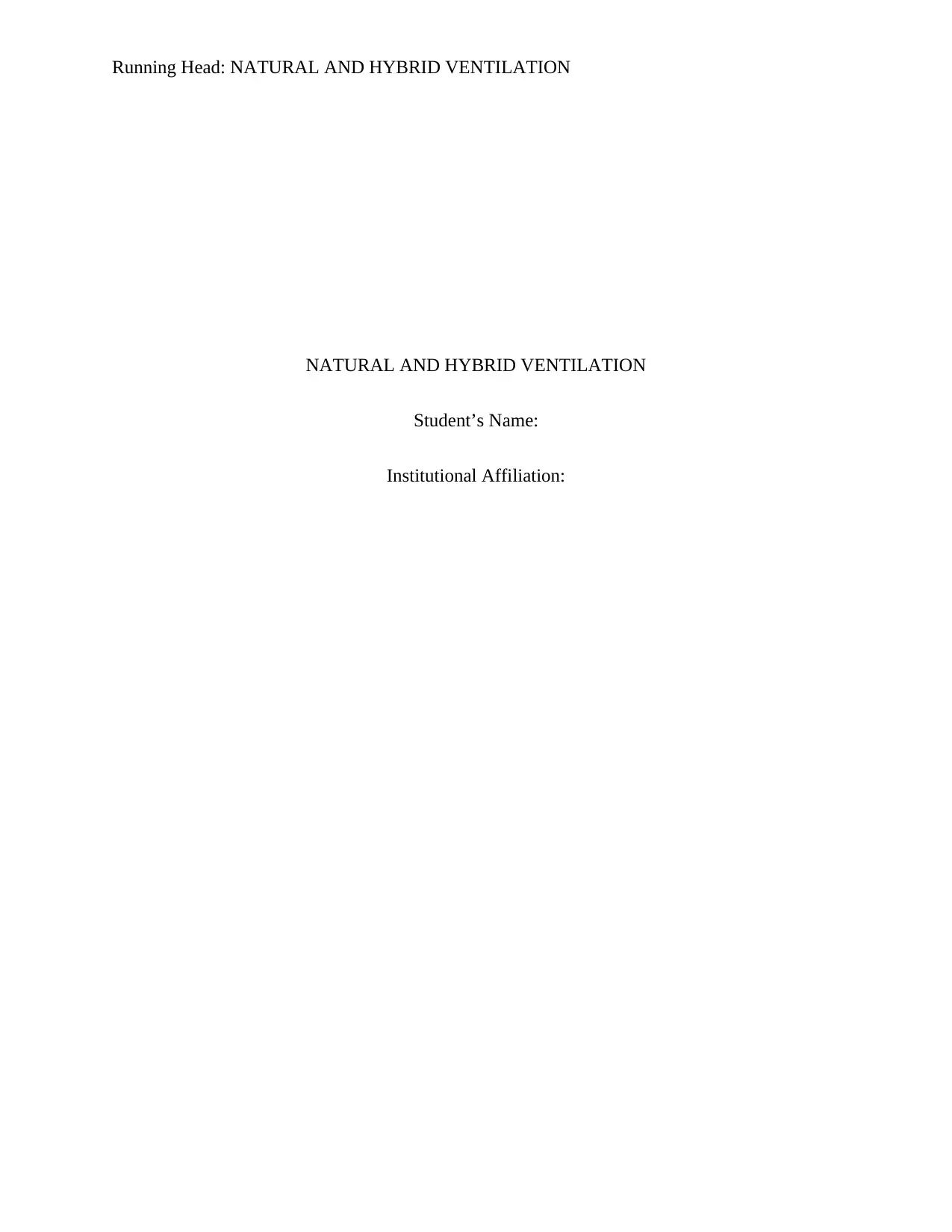
Running Head: NATURAL AND HYBRID VENTILATION
NATURAL AND HYBRID VENTILATION
Student’s Name:
Institutional Affiliation:
NATURAL AND HYBRID VENTILATION
Student’s Name:
Institutional Affiliation:
Paraphrase This Document
Need a fresh take? Get an instant paraphrase of this document with our AI Paraphraser
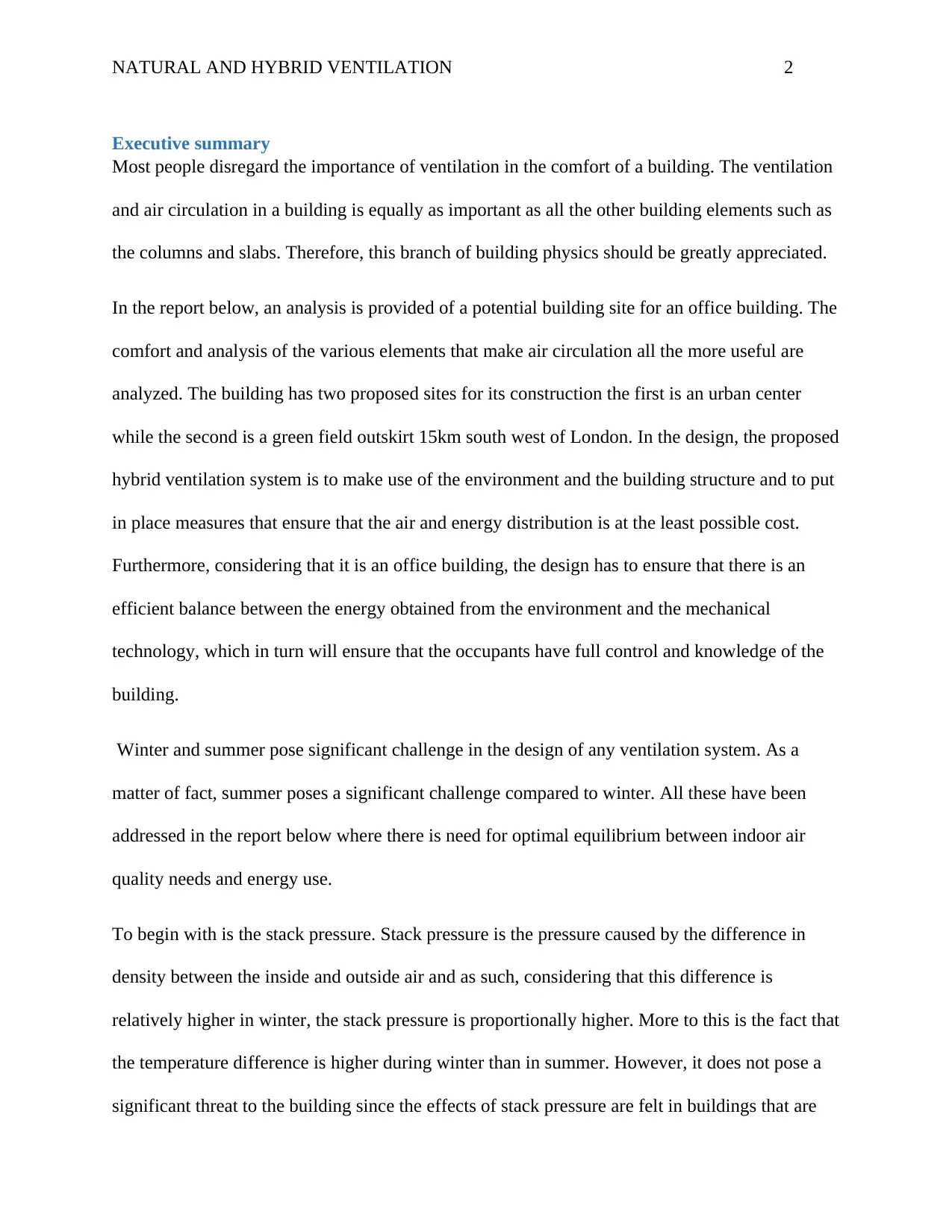
NATURAL AND HYBRID VENTILATION 2
Executive summary
Most people disregard the importance of ventilation in the comfort of a building. The ventilation
and air circulation in a building is equally as important as all the other building elements such as
the columns and slabs. Therefore, this branch of building physics should be greatly appreciated.
In the report below, an analysis is provided of a potential building site for an office building. The
comfort and analysis of the various elements that make air circulation all the more useful are
analyzed. The building has two proposed sites for its construction the first is an urban center
while the second is a green field outskirt 15km south west of London. In the design, the proposed
hybrid ventilation system is to make use of the environment and the building structure and to put
in place measures that ensure that the air and energy distribution is at the least possible cost.
Furthermore, considering that it is an office building, the design has to ensure that there is an
efficient balance between the energy obtained from the environment and the mechanical
technology, which in turn will ensure that the occupants have full control and knowledge of the
building.
Winter and summer pose significant challenge in the design of any ventilation system. As a
matter of fact, summer poses a significant challenge compared to winter. All these have been
addressed in the report below where there is need for optimal equilibrium between indoor air
quality needs and energy use.
To begin with is the stack pressure. Stack pressure is the pressure caused by the difference in
density between the inside and outside air and as such, considering that this difference is
relatively higher in winter, the stack pressure is proportionally higher. More to this is the fact that
the temperature difference is higher during winter than in summer. However, it does not pose a
significant threat to the building since the effects of stack pressure are felt in buildings that are
Executive summary
Most people disregard the importance of ventilation in the comfort of a building. The ventilation
and air circulation in a building is equally as important as all the other building elements such as
the columns and slabs. Therefore, this branch of building physics should be greatly appreciated.
In the report below, an analysis is provided of a potential building site for an office building. The
comfort and analysis of the various elements that make air circulation all the more useful are
analyzed. The building has two proposed sites for its construction the first is an urban center
while the second is a green field outskirt 15km south west of London. In the design, the proposed
hybrid ventilation system is to make use of the environment and the building structure and to put
in place measures that ensure that the air and energy distribution is at the least possible cost.
Furthermore, considering that it is an office building, the design has to ensure that there is an
efficient balance between the energy obtained from the environment and the mechanical
technology, which in turn will ensure that the occupants have full control and knowledge of the
building.
Winter and summer pose significant challenge in the design of any ventilation system. As a
matter of fact, summer poses a significant challenge compared to winter. All these have been
addressed in the report below where there is need for optimal equilibrium between indoor air
quality needs and energy use.
To begin with is the stack pressure. Stack pressure is the pressure caused by the difference in
density between the inside and outside air and as such, considering that this difference is
relatively higher in winter, the stack pressure is proportionally higher. More to this is the fact that
the temperature difference is higher during winter than in summer. However, it does not pose a
significant threat to the building since the effects of stack pressure are felt in buildings that are
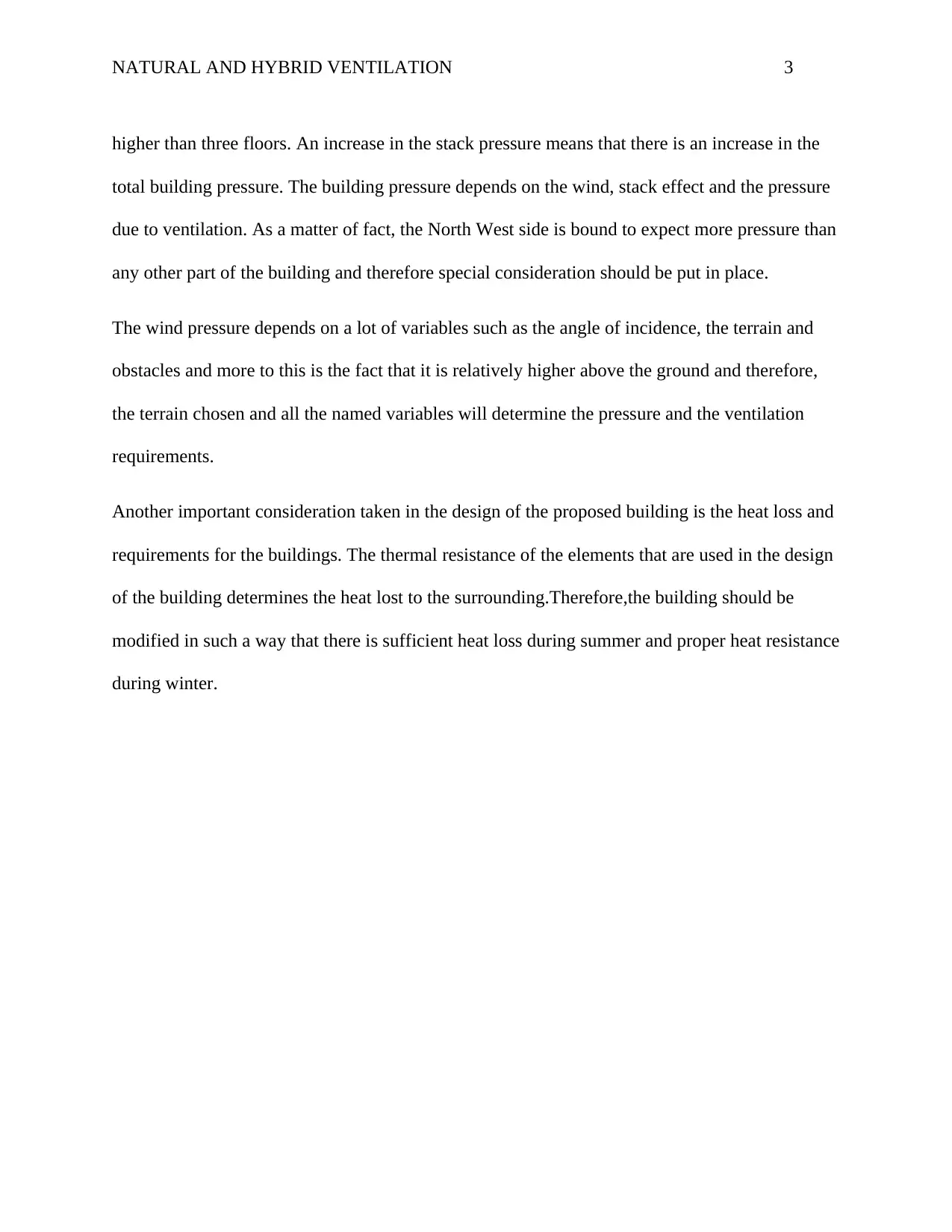
NATURAL AND HYBRID VENTILATION 3
higher than three floors. An increase in the stack pressure means that there is an increase in the
total building pressure. The building pressure depends on the wind, stack effect and the pressure
due to ventilation. As a matter of fact, the North West side is bound to expect more pressure than
any other part of the building and therefore special consideration should be put in place.
The wind pressure depends on a lot of variables such as the angle of incidence, the terrain and
obstacles and more to this is the fact that it is relatively higher above the ground and therefore,
the terrain chosen and all the named variables will determine the pressure and the ventilation
requirements.
Another important consideration taken in the design of the proposed building is the heat loss and
requirements for the buildings. The thermal resistance of the elements that are used in the design
of the building determines the heat lost to the surrounding.Therefore,the building should be
modified in such a way that there is sufficient heat loss during summer and proper heat resistance
during winter.
higher than three floors. An increase in the stack pressure means that there is an increase in the
total building pressure. The building pressure depends on the wind, stack effect and the pressure
due to ventilation. As a matter of fact, the North West side is bound to expect more pressure than
any other part of the building and therefore special consideration should be put in place.
The wind pressure depends on a lot of variables such as the angle of incidence, the terrain and
obstacles and more to this is the fact that it is relatively higher above the ground and therefore,
the terrain chosen and all the named variables will determine the pressure and the ventilation
requirements.
Another important consideration taken in the design of the proposed building is the heat loss and
requirements for the buildings. The thermal resistance of the elements that are used in the design
of the building determines the heat lost to the surrounding.Therefore,the building should be
modified in such a way that there is sufficient heat loss during summer and proper heat resistance
during winter.
⊘ This is a preview!⊘
Do you want full access?
Subscribe today to unlock all pages.

Trusted by 1+ million students worldwide
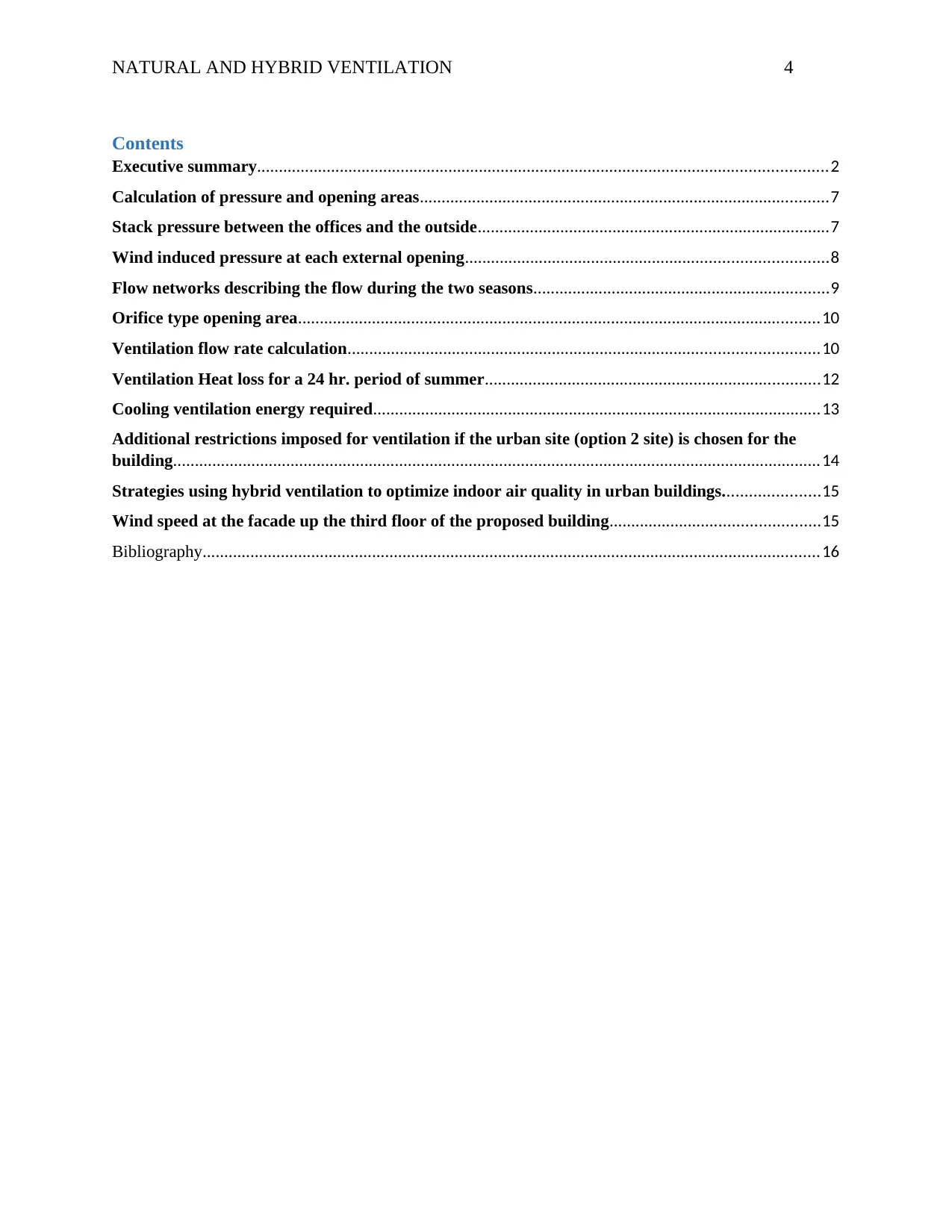
NATURAL AND HYBRID VENTILATION 4
Contents
Executive summary...................................................................................................................................2
Calculation of pressure and opening areas..............................................................................................7
Stack pressure between the offices and the outside.................................................................................7
Wind induced pressure at each external opening...................................................................................8
Flow networks describing the flow during the two seasons....................................................................9
Orifice type opening area........................................................................................................................10
Ventilation flow rate calculation............................................................................................................10
Ventilation Heat loss for a 24 hr. period of summer.............................................................................12
Cooling ventilation energy required.......................................................................................................13
Additional restrictions imposed for ventilation if the urban site (option 2 site) is chosen for the
building.....................................................................................................................................................14
Strategies using hybrid ventilation to optimize indoor air quality in urban buildings......................15
Wind speed at the facade up the third floor of the proposed building................................................15
Bibliography..............................................................................................................................................16
Contents
Executive summary...................................................................................................................................2
Calculation of pressure and opening areas..............................................................................................7
Stack pressure between the offices and the outside.................................................................................7
Wind induced pressure at each external opening...................................................................................8
Flow networks describing the flow during the two seasons....................................................................9
Orifice type opening area........................................................................................................................10
Ventilation flow rate calculation............................................................................................................10
Ventilation Heat loss for a 24 hr. period of summer.............................................................................12
Cooling ventilation energy required.......................................................................................................13
Additional restrictions imposed for ventilation if the urban site (option 2 site) is chosen for the
building.....................................................................................................................................................14
Strategies using hybrid ventilation to optimize indoor air quality in urban buildings......................15
Wind speed at the facade up the third floor of the proposed building................................................15
Bibliography..............................................................................................................................................16
Paraphrase This Document
Need a fresh take? Get an instant paraphrase of this document with our AI Paraphraser
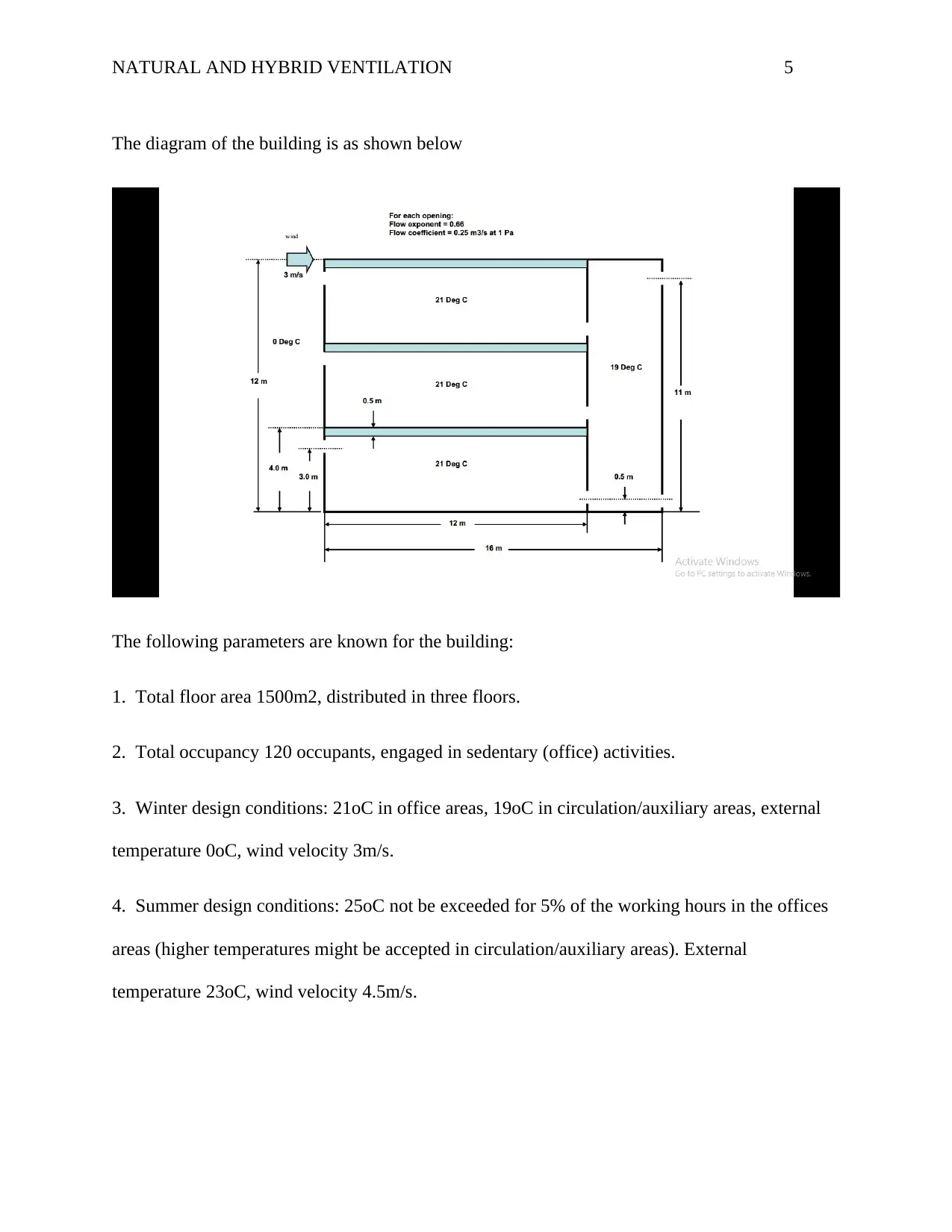
NATURAL AND HYBRID VENTILATION 5
The diagram of the building is as shown below
The following parameters are known for the building:
1. Total floor area 1500m2, distributed in three floors.
2. Total occupancy 120 occupants, engaged in sedentary (office) activities.
3. Winter design conditions: 21oC in office areas, 19oC in circulation/auxiliary areas, external
temperature 0oC, wind velocity 3m/s.
4. Summer design conditions: 25oC not be exceeded for 5% of the working hours in the offices
areas (higher temperatures might be accepted in circulation/auxiliary areas). External
temperature 23oC, wind velocity 4.5m/s.
The diagram of the building is as shown below
The following parameters are known for the building:
1. Total floor area 1500m2, distributed in three floors.
2. Total occupancy 120 occupants, engaged in sedentary (office) activities.
3. Winter design conditions: 21oC in office areas, 19oC in circulation/auxiliary areas, external
temperature 0oC, wind velocity 3m/s.
4. Summer design conditions: 25oC not be exceeded for 5% of the working hours in the offices
areas (higher temperatures might be accepted in circulation/auxiliary areas). External
temperature 23oC, wind velocity 4.5m/s.
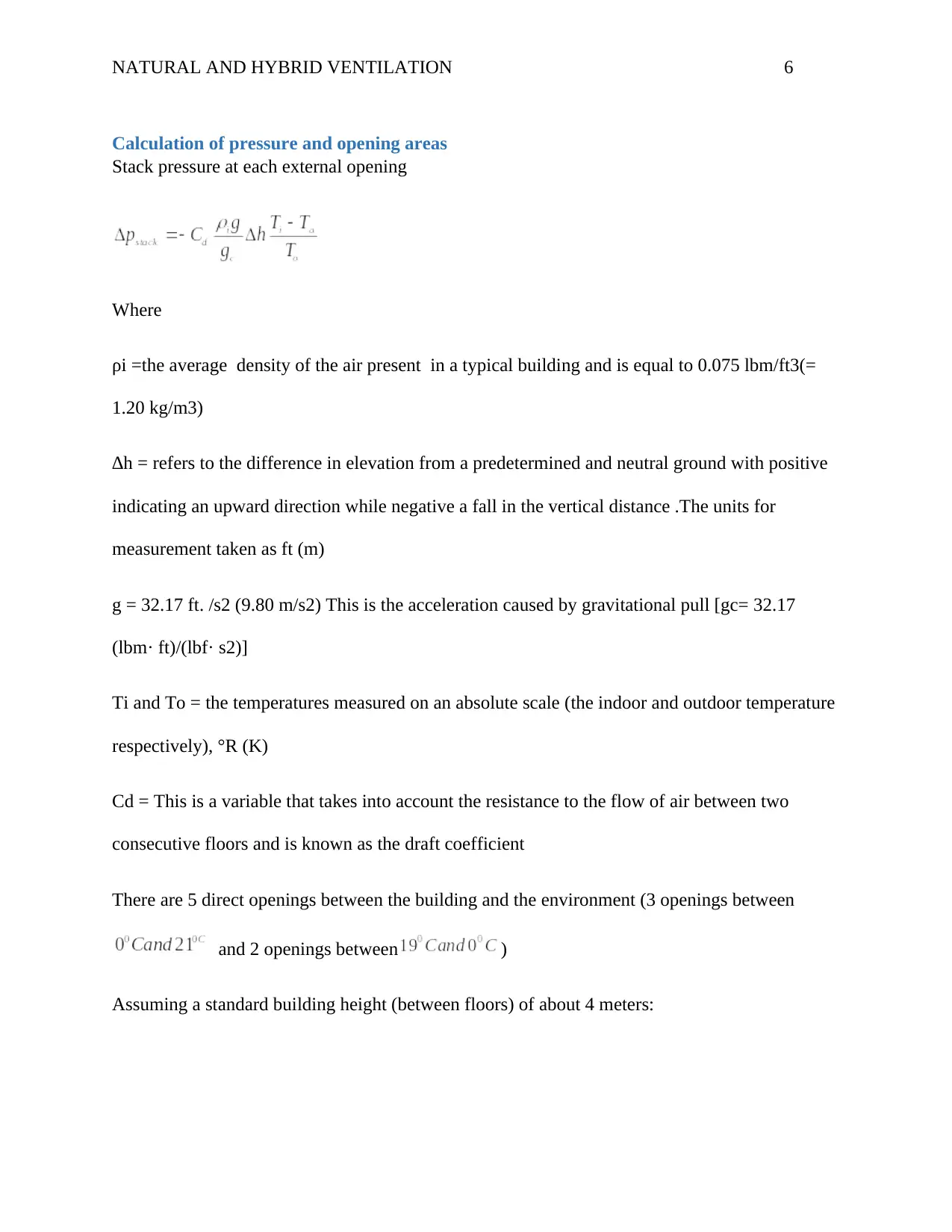
NATURAL AND HYBRID VENTILATION 6
Calculation of pressure and opening areas
Stack pressure at each external opening
Where
ρi =the average density of the air present in a typical building and is equal to 0.075 lbm/ft3(=
1.20 kg/m3)
∆h = refers to the difference in elevation from a predetermined and neutral ground with positive
indicating an upward direction while negative a fall in the vertical distance .The units for
measurement taken as ft (m)
g = 32.17 ft. /s2 (9.80 m/s2) This is the acceleration caused by gravitational pull [gc= 32.17
(lbm· ft)/(lbf· s2)]
Ti and To = the temperatures measured on an absolute scale (the indoor and outdoor temperature
respectively), °R (K)
Cd = This is a variable that takes into account the resistance to the flow of air between two
consecutive floors and is known as the draft coefficient
There are 5 direct openings between the building and the environment (3 openings between
and 2 openings between )
Assuming a standard building height (between floors) of about 4 meters:
Calculation of pressure and opening areas
Stack pressure at each external opening
Where
ρi =the average density of the air present in a typical building and is equal to 0.075 lbm/ft3(=
1.20 kg/m3)
∆h = refers to the difference in elevation from a predetermined and neutral ground with positive
indicating an upward direction while negative a fall in the vertical distance .The units for
measurement taken as ft (m)
g = 32.17 ft. /s2 (9.80 m/s2) This is the acceleration caused by gravitational pull [gc= 32.17
(lbm· ft)/(lbf· s2)]
Ti and To = the temperatures measured on an absolute scale (the indoor and outdoor temperature
respectively), °R (K)
Cd = This is a variable that takes into account the resistance to the flow of air between two
consecutive floors and is known as the draft coefficient
There are 5 direct openings between the building and the environment (3 openings between
and 2 openings between )
Assuming a standard building height (between floors) of about 4 meters:
⊘ This is a preview!⊘
Do you want full access?
Subscribe today to unlock all pages.

Trusted by 1+ million students worldwide
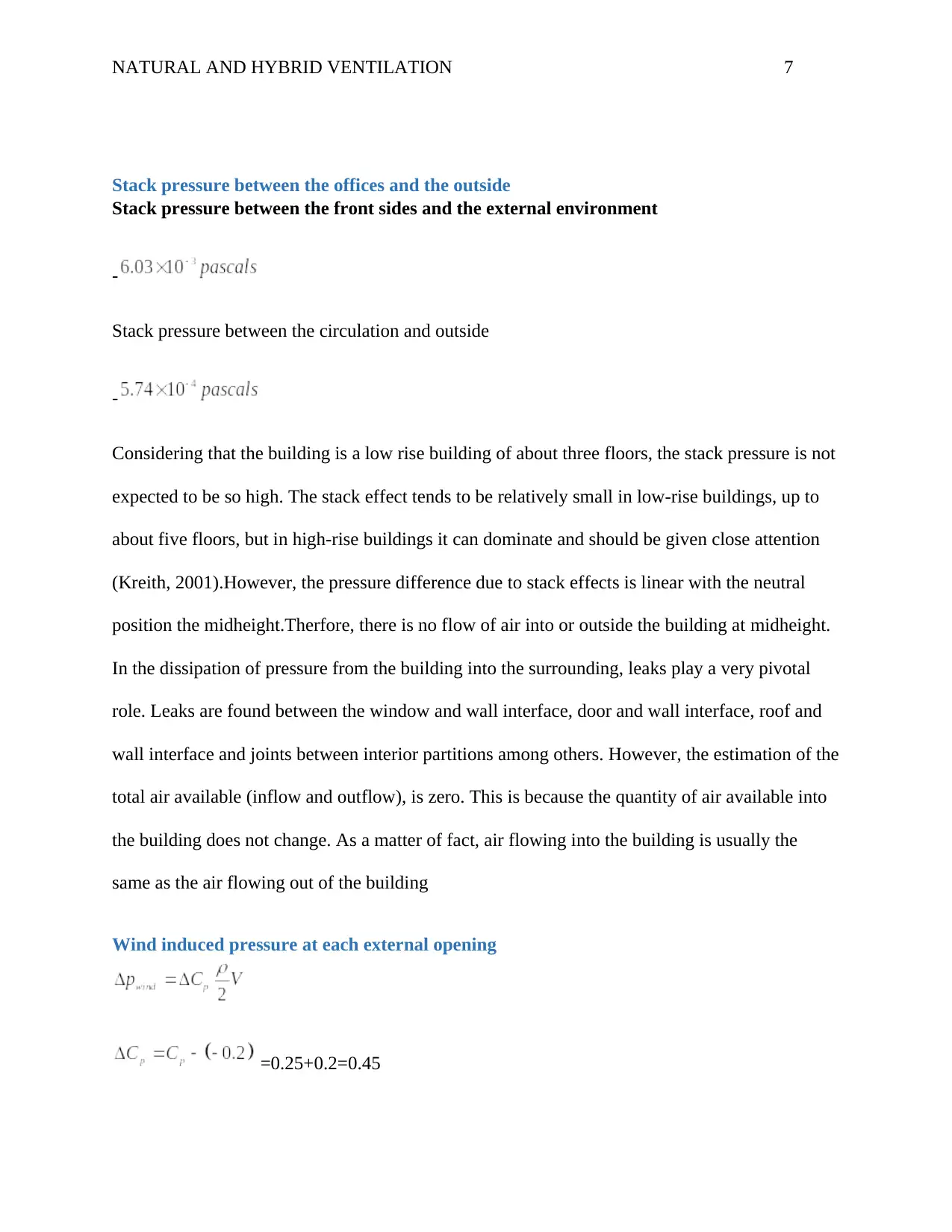
NATURAL AND HYBRID VENTILATION 7
Stack pressure between the offices and the outside
Stack pressure between the front sides and the external environment
-
Stack pressure between the circulation and outside
-
Considering that the building is a low rise building of about three floors, the stack pressure is not
expected to be so high. The stack effect tends to be relatively small in low-rise buildings, up to
about five floors, but in high-rise buildings it can dominate and should be given close attention
(Kreith, 2001).However, the pressure difference due to stack effects is linear with the neutral
position the midheight.Therfore, there is no flow of air into or outside the building at midheight.
In the dissipation of pressure from the building into the surrounding, leaks play a very pivotal
role. Leaks are found between the window and wall interface, door and wall interface, roof and
wall interface and joints between interior partitions among others. However, the estimation of the
total air available (inflow and outflow), is zero. This is because the quantity of air available into
the building does not change. As a matter of fact, air flowing into the building is usually the
same as the air flowing out of the building
Wind induced pressure at each external opening
=0.25+0.2=0.45
Stack pressure between the offices and the outside
Stack pressure between the front sides and the external environment
-
Stack pressure between the circulation and outside
-
Considering that the building is a low rise building of about three floors, the stack pressure is not
expected to be so high. The stack effect tends to be relatively small in low-rise buildings, up to
about five floors, but in high-rise buildings it can dominate and should be given close attention
(Kreith, 2001).However, the pressure difference due to stack effects is linear with the neutral
position the midheight.Therfore, there is no flow of air into or outside the building at midheight.
In the dissipation of pressure from the building into the surrounding, leaks play a very pivotal
role. Leaks are found between the window and wall interface, door and wall interface, roof and
wall interface and joints between interior partitions among others. However, the estimation of the
total air available (inflow and outflow), is zero. This is because the quantity of air available into
the building does not change. As a matter of fact, air flowing into the building is usually the
same as the air flowing out of the building
Wind induced pressure at each external opening
=0.25+0.2=0.45
Paraphrase This Document
Need a fresh take? Get an instant paraphrase of this document with our AI Paraphraser
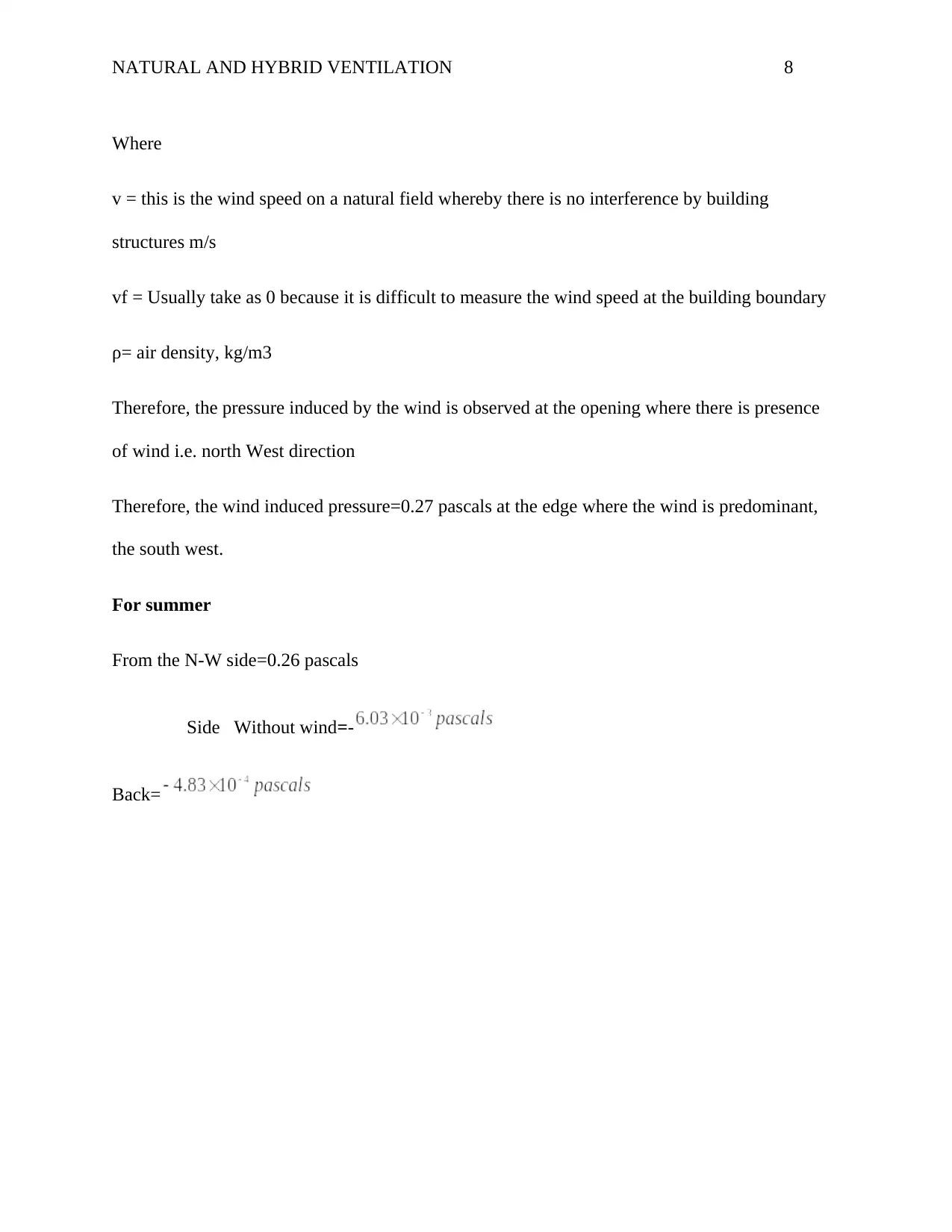
NATURAL AND HYBRID VENTILATION 8
Where
v = this is the wind speed on a natural field whereby there is no interference by building
structures m/s
vf = Usually take as 0 because it is difficult to measure the wind speed at the building boundary
ρ= air density, kg/m3
Therefore, the pressure induced by the wind is observed at the opening where there is presence
of wind i.e. north West direction
Therefore, the wind induced pressure=0.27 pascals at the edge where the wind is predominant,
the south west.
For summer
From the N-W side=0.26 pascals
Side Without wind=-
Back=
Where
v = this is the wind speed on a natural field whereby there is no interference by building
structures m/s
vf = Usually take as 0 because it is difficult to measure the wind speed at the building boundary
ρ= air density, kg/m3
Therefore, the pressure induced by the wind is observed at the opening where there is presence
of wind i.e. north West direction
Therefore, the wind induced pressure=0.27 pascals at the edge where the wind is predominant,
the south west.
For summer
From the N-W side=0.26 pascals
Side Without wind=-
Back=
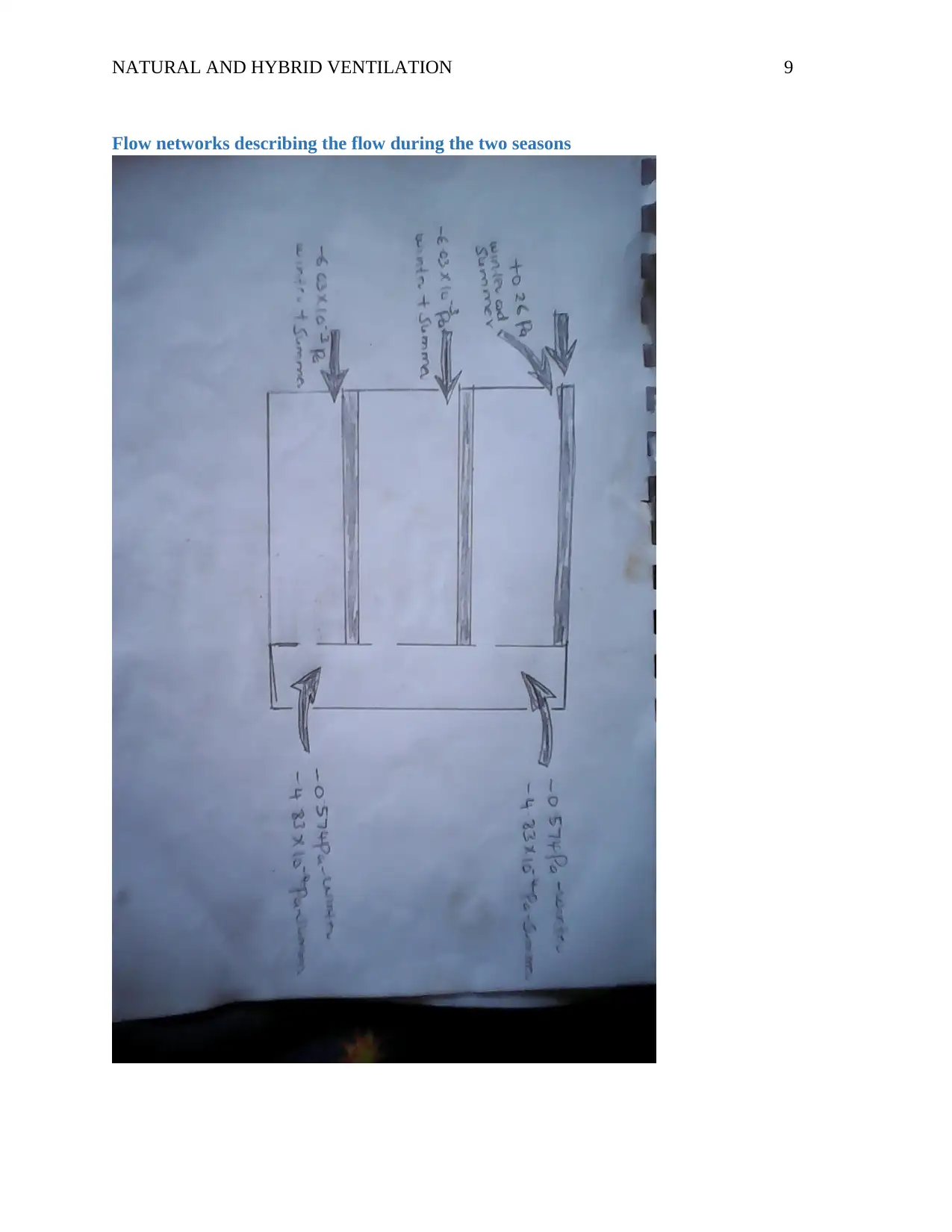
NATURAL AND HYBRID VENTILATION 9
Flow networks describing the flow during the two seasons
Flow networks describing the flow during the two seasons
⊘ This is a preview!⊘
Do you want full access?
Subscribe today to unlock all pages.

Trusted by 1+ million students worldwide
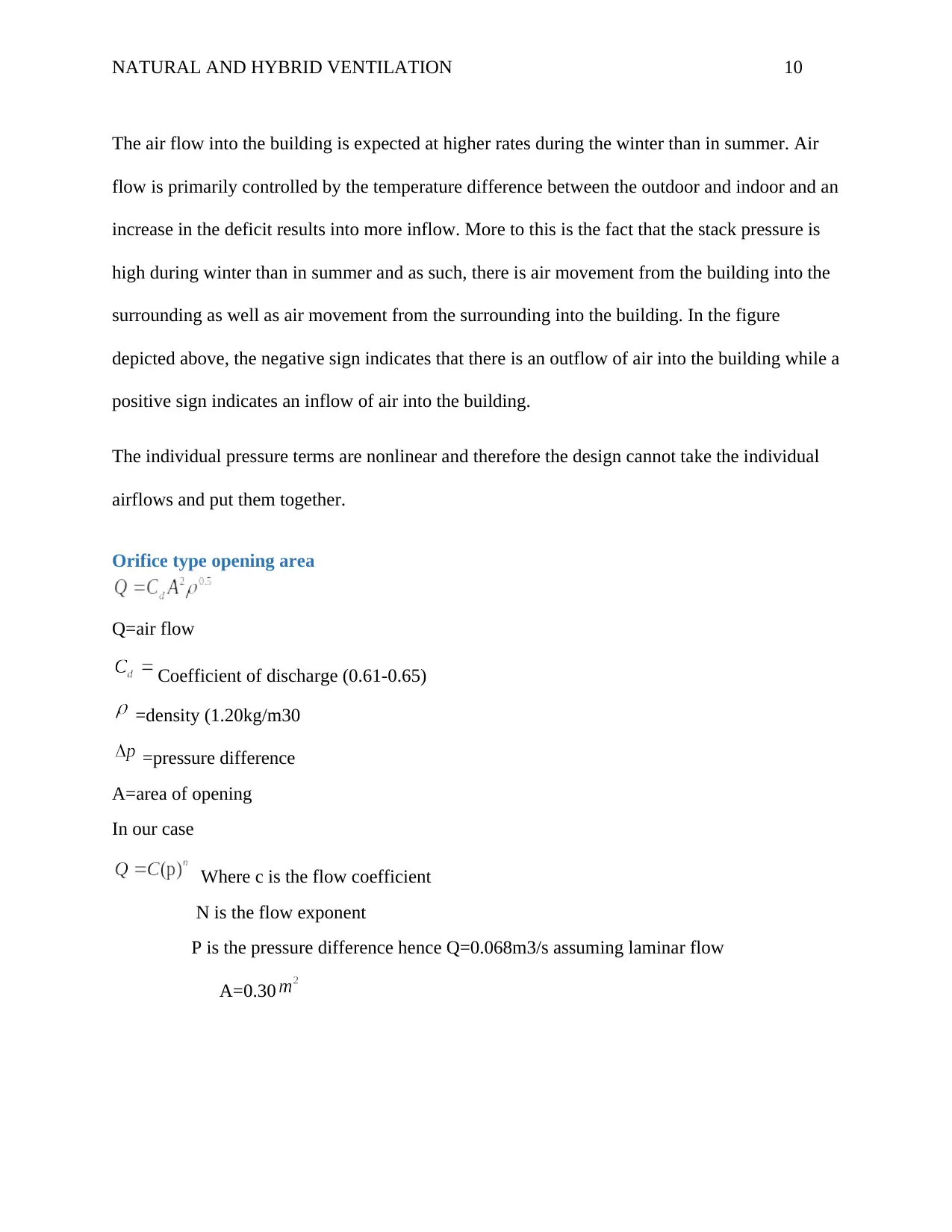
NATURAL AND HYBRID VENTILATION 10
The air flow into the building is expected at higher rates during the winter than in summer. Air
flow is primarily controlled by the temperature difference between the outdoor and indoor and an
increase in the deficit results into more inflow. More to this is the fact that the stack pressure is
high during winter than in summer and as such, there is air movement from the building into the
surrounding as well as air movement from the surrounding into the building. In the figure
depicted above, the negative sign indicates that there is an outflow of air into the building while a
positive sign indicates an inflow of air into the building.
The individual pressure terms are nonlinear and therefore the design cannot take the individual
airflows and put them together.
Orifice type opening area
Q=air flow
Coefficient of discharge (0.61-0.65)
=density (1.20kg/m30
=pressure difference
A=area of opening
In our case
Where c is the flow coefficient
N is the flow exponent
P is the pressure difference hence Q=0.068m3/s assuming laminar flow
A=0.30
The air flow into the building is expected at higher rates during the winter than in summer. Air
flow is primarily controlled by the temperature difference between the outdoor and indoor and an
increase in the deficit results into more inflow. More to this is the fact that the stack pressure is
high during winter than in summer and as such, there is air movement from the building into the
surrounding as well as air movement from the surrounding into the building. In the figure
depicted above, the negative sign indicates that there is an outflow of air into the building while a
positive sign indicates an inflow of air into the building.
The individual pressure terms are nonlinear and therefore the design cannot take the individual
airflows and put them together.
Orifice type opening area
Q=air flow
Coefficient of discharge (0.61-0.65)
=density (1.20kg/m30
=pressure difference
A=area of opening
In our case
Where c is the flow coefficient
N is the flow exponent
P is the pressure difference hence Q=0.068m3/s assuming laminar flow
A=0.30
Paraphrase This Document
Need a fresh take? Get an instant paraphrase of this document with our AI Paraphraser
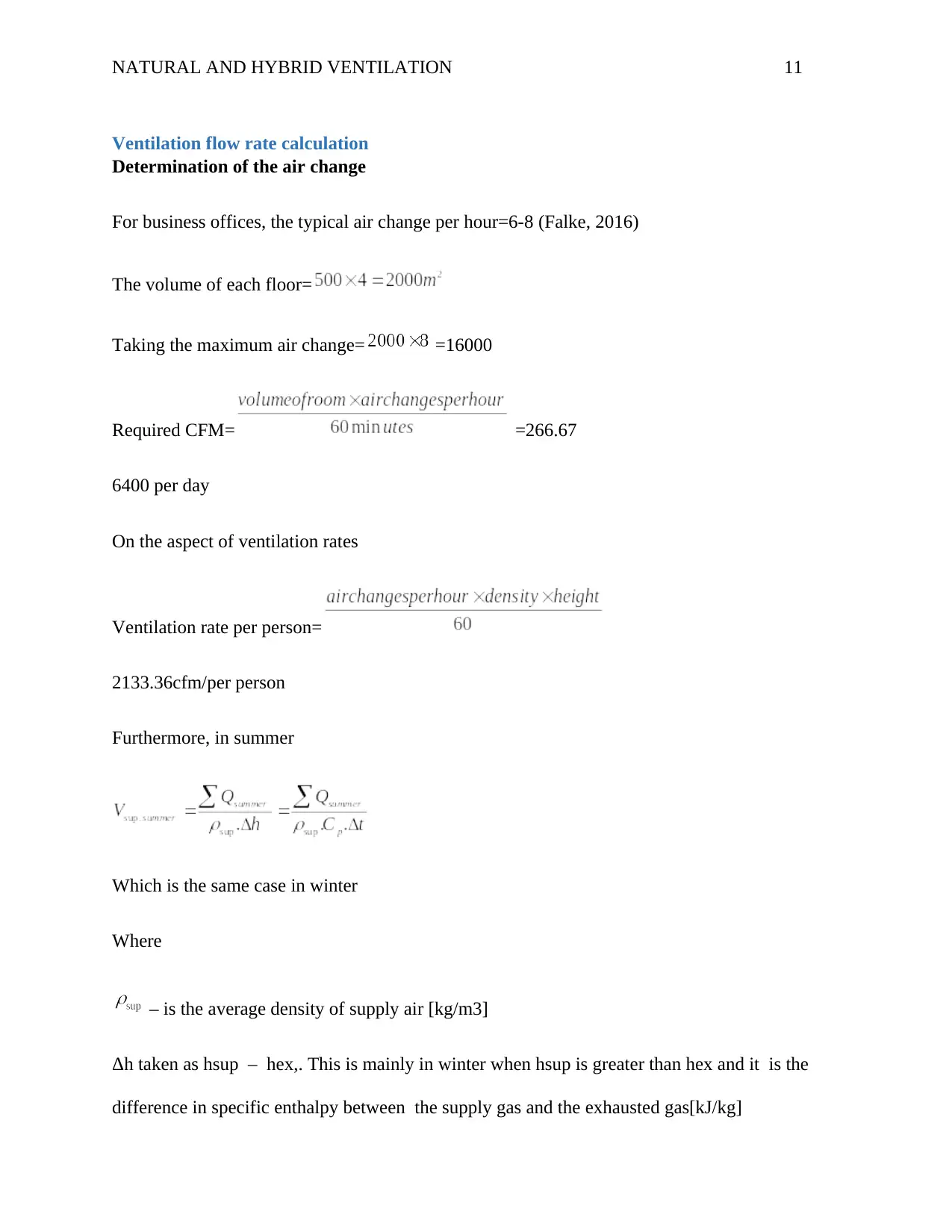
NATURAL AND HYBRID VENTILATION 11
Ventilation flow rate calculation
Determination of the air change
For business offices, the typical air change per hour=6-8 (Falke, 2016)
The volume of each floor=
Taking the maximum air change= =16000
Required CFM= =266.67
6400 per day
On the aspect of ventilation rates
Ventilation rate per person=
2133.36cfm/per person
Furthermore, in summer
Which is the same case in winter
Where
– is the average density of supply air [kg/m3]
Δh taken as hsup – hex,. This is mainly in winter when hsup is greater than hex and it is the
difference in specific enthalpy between the supply gas and the exhausted gas[kJ/kg]
Ventilation flow rate calculation
Determination of the air change
For business offices, the typical air change per hour=6-8 (Falke, 2016)
The volume of each floor=
Taking the maximum air change= =16000
Required CFM= =266.67
6400 per day
On the aspect of ventilation rates
Ventilation rate per person=
2133.36cfm/per person
Furthermore, in summer
Which is the same case in winter
Where
– is the average density of supply air [kg/m3]
Δh taken as hsup – hex,. This is mainly in winter when hsup is greater than hex and it is the
difference in specific enthalpy between the supply gas and the exhausted gas[kJ/kg]
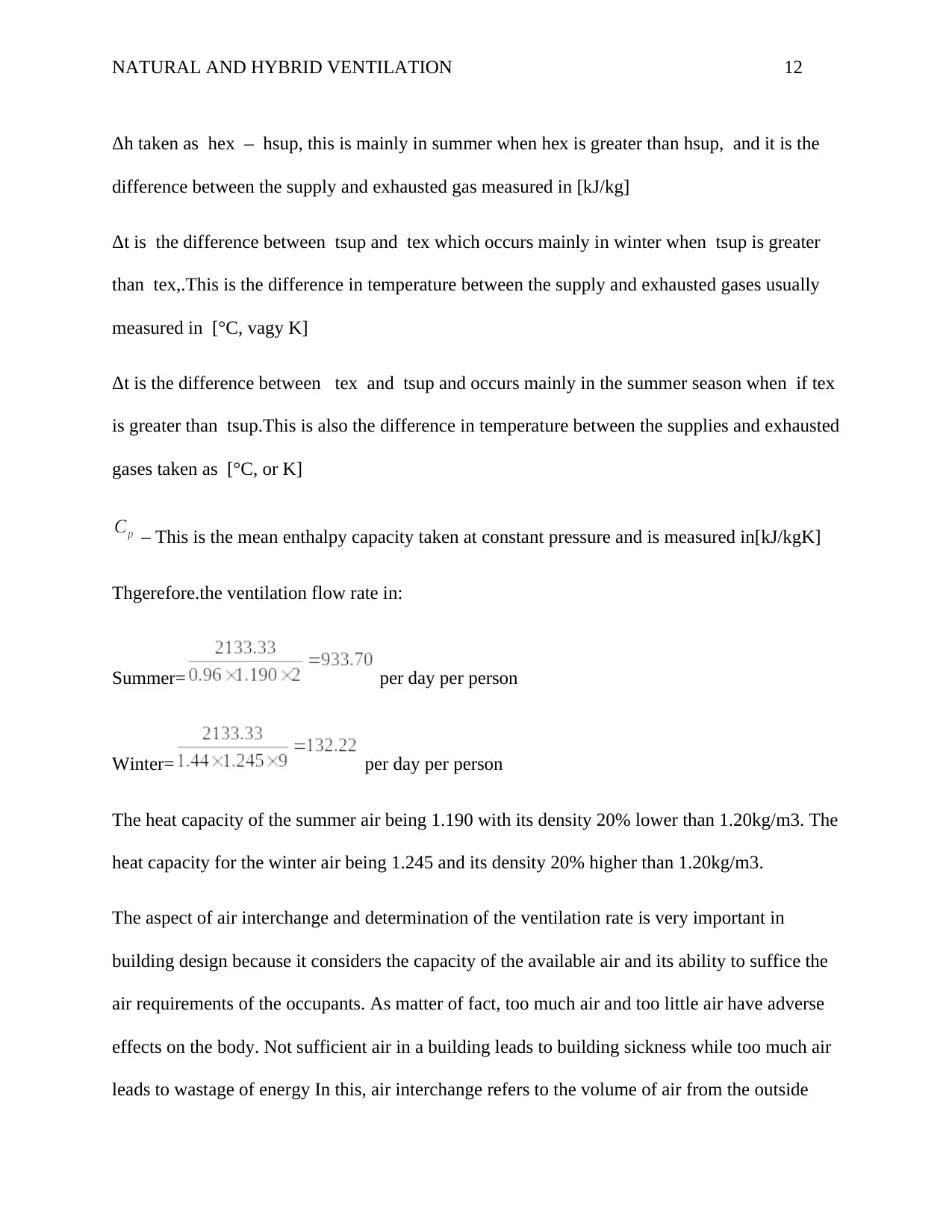
NATURAL AND HYBRID VENTILATION 12
Δh taken as hex – hsup, this is mainly in summer when hex is greater than hsup, and it is the
difference between the supply and exhausted gas measured in [kJ/kg]
Δt is the difference between tsup and tex which occurs mainly in winter when tsup is greater
than tex,.This is the difference in temperature between the supply and exhausted gases usually
measured in [°C, vagy K]
Δt is the difference between tex and tsup and occurs mainly in the summer season when if tex
is greater than tsup.This is also the difference in temperature between the supplies and exhausted
gases taken as [°C, or K]
– This is the mean enthalpy capacity taken at constant pressure and is measured in[kJ/kgK]
Thgerefore.the ventilation flow rate in:
Summer= per day per person
Winter= per day per person
The heat capacity of the summer air being 1.190 with its density 20% lower than 1.20kg/m3. The
heat capacity for the winter air being 1.245 and its density 20% higher than 1.20kg/m3.
The aspect of air interchange and determination of the ventilation rate is very important in
building design because it considers the capacity of the available air and its ability to suffice the
air requirements of the occupants. As matter of fact, too much air and too little air have adverse
effects on the body. Not sufficient air in a building leads to building sickness while too much air
leads to wastage of energy In this, air interchange refers to the volume of air from the outside
Δh taken as hex – hsup, this is mainly in summer when hex is greater than hsup, and it is the
difference between the supply and exhausted gas measured in [kJ/kg]
Δt is the difference between tsup and tex which occurs mainly in winter when tsup is greater
than tex,.This is the difference in temperature between the supply and exhausted gases usually
measured in [°C, vagy K]
Δt is the difference between tex and tsup and occurs mainly in the summer season when if tex
is greater than tsup.This is also the difference in temperature between the supplies and exhausted
gases taken as [°C, or K]
– This is the mean enthalpy capacity taken at constant pressure and is measured in[kJ/kgK]
Thgerefore.the ventilation flow rate in:
Summer= per day per person
Winter= per day per person
The heat capacity of the summer air being 1.190 with its density 20% lower than 1.20kg/m3. The
heat capacity for the winter air being 1.245 and its density 20% higher than 1.20kg/m3.
The aspect of air interchange and determination of the ventilation rate is very important in
building design because it considers the capacity of the available air and its ability to suffice the
air requirements of the occupants. As matter of fact, too much air and too little air have adverse
effects on the body. Not sufficient air in a building leads to building sickness while too much air
leads to wastage of energy In this, air interchange refers to the volume of air from the outside
⊘ This is a preview!⊘
Do you want full access?
Subscribe today to unlock all pages.

Trusted by 1+ million students worldwide
1 out of 23
Your All-in-One AI-Powered Toolkit for Academic Success.
+13062052269
info@desklib.com
Available 24*7 on WhatsApp / Email
![[object Object]](/_next/static/media/star-bottom.7253800d.svg)
Unlock your academic potential
Copyright © 2020–2025 A2Z Services. All Rights Reserved. Developed and managed by ZUCOL.
